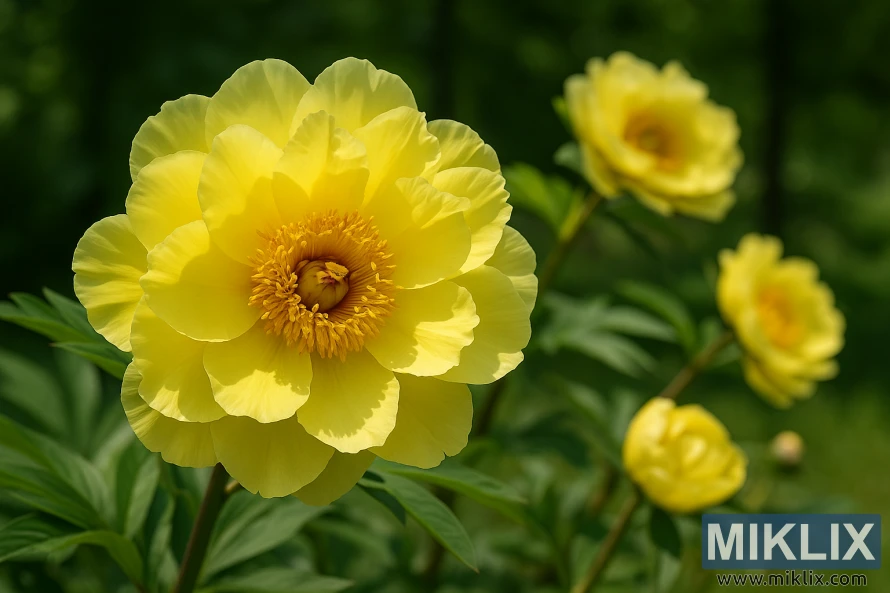Image: Close-Up of High Noon Tree Peony in Full Bloom
Published: October 19, 2025 at 8:59:25 PM UTC
Explore the radiant beauty of the High Noon tree peony in this close-up photo, showcasing its large golden-yellow blooms, silky petals, and striking details in a vibrant garden setting.
The image captures a stunning close-up of a High Noon tree peony (Paeonia suffruticosa 'High Noon') in full bloom, highlighting the exceptional beauty and elegance that have made this variety one of the most admired yellow peonies in the world. Dominating the composition is a single, fully opened flower, its radiant golden-yellow petals unfolding gracefully in layered perfection. The petals are broad, silky, and gently undulating, arranged in a harmonious, rounded form that radiates outward from a vibrant central core. Their luminous color glows warmly in the soft, natural light, creating an almost sunlit effect that enhances the flower’s name and character.
At the heart of the bloom lies a striking contrast: a dense cluster of bright orange-yellow stamens encircling a small but vivid reddish center, adding depth and visual drama to the composition. The stamens’ delicate filaments and pollen-laden anthers are captured in exquisite detail, their fine texture contrasting beautifully with the smooth, satiny surfaces of the surrounding petals. This central structure not only draws the viewer’s gaze inward but also serves as a dynamic focal point, emphasizing the flower’s vitality and reproductive energy.
The surrounding petals exhibit subtle tonal variations, with deeper golden hues near the base transitioning to a softer, buttery yellow at the edges. This gentle gradient enhances the three-dimensional quality of the bloom, while the way light plays across the petal surfaces accentuates their delicate veining and natural curvature. The bloom’s size and fullness are immediately apparent, a hallmark of High Noon, which is renowned for producing exceptionally large, showy flowers that can reach impressive dimensions in the garden landscape.
In the background, several more High Noon blossoms appear at varying stages of bloom, softly blurred by a shallow depth of field. This effect creates a sense of depth and context, suggesting a thriving tree peony shrub laden with blooms. The rich green foliage beneath and behind the flowers offers a lush, contrasting backdrop, intensifying the brilliance of the yellow petals. The finely divided, slightly glossy leaves frame the main bloom naturally, grounding it within its environment and enhancing the composition’s botanical authenticity.
The lighting is soft and natural, likely captured in the gentle glow of morning or late afternoon sun, lending the entire scene a serene, almost painterly quality. The interplay of light and shadow adds dimension and texture, highlighting the peony’s sculptural form and the subtle intricacies of its structure. The image as a whole conveys a sense of freshness, vitality, and abundance—hallmarks of a tree peony in peak bloom.
More than just a floral portrait, this image encapsulates the essence of the High Noon peony: bold yet refined, radiant yet delicate. Its golden blooms symbolize warmth, prosperity, and joy, while its elegant structure and impressive size speak to centuries of horticultural refinement. This variety remains a centerpiece in gardens and floral displays worldwide, cherished for its rare color, impressive presence, and timeless beauty. The photograph captures all of these qualities in stunning detail, offering a vivid celebration of one of nature’s most captivating floral masterpieces.
The image is related to: The Most Beautiful Varieties of Peony Flowers to Grow in Your Garden

